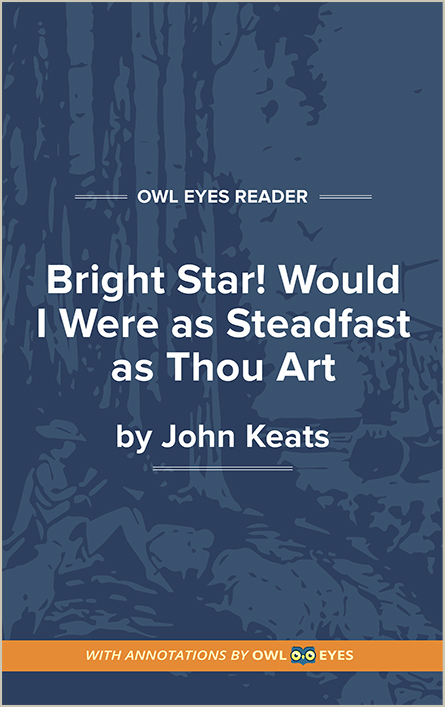
Literary Devices in Brilliant Star! Would I Were Steadfast as G Art
The Sonnet Form: "Bright Star!" is an example of the Elizabethan sonnet, also known as the Shakespearean or English sonnet. The Elizabethan sonnet has fourteen lines which consist of iii stanzas with an ABAB rhyme scheme followed past a rhymed couplet. The meter is the standard iambic pentameter.
Personification: I of the master literary devices Keats uses in "Brilliant Star!" is personification, a device he uses in many of his poems. The speaker, gazing upon the natural world, sees human qualities in the both the North Star in a higher place and the water beneath. The star watches the globe from a distance; the h2o cleanses the shore. Such personification illuminates the speaker'southward inner imagined world.
Tension and Contrast: As the poem progresses into the 2d half, Keats makes increasing utilise of formal contrasts to illustrate the speaker's inner tensions. The volta, the thematic turn at the sonnet's ninth line, foregrounds the poem's fundamental tension: "No—nevertheless however steadfast, nevertheless unchangeable." The speaker acknowledges the bang-up gulf—both in distance and grapheme—between himself and the admired North Star. The concluding line carries tremendous tension as well, for the speaker expresses his want to "alive always—or else swoon to death." The speaker wishes to remain in a moment of rapture with his lover but knows he cannot.
Literary Devices Examples in Bright Star! Would I Were Steadfast as Thou Art:
Bright Star!
🔒 5 "Still, withal..." Meet in text(Bright Star!)
The repetition of "yet" here takes on ii meanings of the discussion. As an describing word, "still" can mean non moving or making a sound. As an adverb, it can besides refer to fourth dimension spent doing an activeness, even now. In the repetition, the speaker says that he lies still in order to proceed to hear her breath. In a sense, his only mode to combat the progression of time is to make his body as motionless every bit possible. Notice the subtle irony that underlies this statement: the speaker must become motionless to make the moment terminal longer; he must mimic decease in order to gain the feeling of everlasting life.
Caitlin, Owl Eyes Staff
Subscribe to unlock »
"sweetness unrest..." See in text(Vivid Star!)
The phrase "sweet unrest" is an oxymoron, or a figure of speech in which contradictory terms are placed in conjunction for accent. Sweet means pleasing to the senses; unrest, disharmony or strife. This oxymoron underscores the speaker's internal struggle: the moment is sweet but his knowledge that it will eventually stop causes him unrest. The moment is perfect and information technology makes it bloodshot.
Caitlin, Owl Eyes Staff
Subscribe to unlock »
"fall and dandy..." See in text(Bright Star!)
The speaker describes the woman's breaths as a process of "fall and groovy." In this description, he once again shows the fluctuation between 2 things rather than the continuous existence of 1 matter. Notice that within this line the speaker juxtaposes the paradoxically opposing forces that command the moment: his desire to "experience for always" and the rhythmic breath of his lover that signifies the progression of time.
Caitlin, Owl Eyes Staff
Subscribe to unlock »
"No..." Meet in text(Brilliant Star!)
This line opens with the word "no," which reinforces the speaker'south claims about how he does not want to be like the star. The give-and-take "nevertheless" here marks the commencement of a new idea. The speaker repeats his desire to remain "steadfast" and then goes on to explain what he means by this and why he desires information technology.
Caitlin, Owl Eyes Staff
Subscribe to unlock »
"yet..." Run into in text(Bright Star!)
In a Shakespearean sonnet, line nine signifies the volta, or thematic turn, within the poem. The first two quatrains fix an argument that is so complicated by the final quatrain and couplet. In this poem, line nine marks a volta. However, unlike a traditional sonnet, the first eight lines exercise not build an argument to complicate. Instead, the speaker begins by stating the theme of the point, digresses to clarify the merits of the kickoff line, and then returns to his original point at the volta.
Caitlin, Owl Eyes Staff
Subscribe to unlock »
andesbrok1996.blogspot.com
Source: https://www.owleyes.org/text/bright-star/analysis/literary-devices

0 Response to "Bright Star Would I Were Steadfast as Thou Art äâ¸âã¦â€â€¡"
Post a Comment